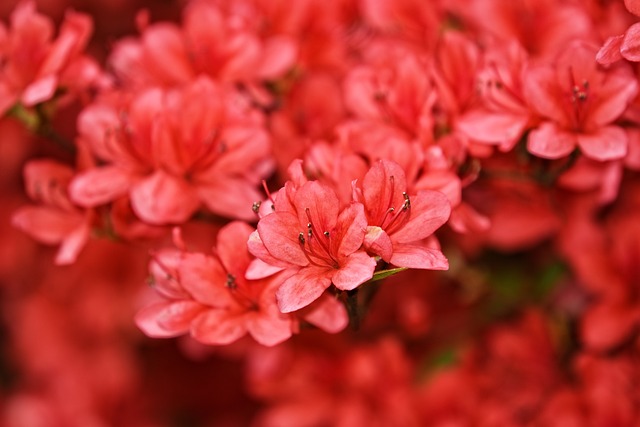Mastering Azalea Care: A Comprehensive Guide
Welcome to our comprehensive Garden Guide on Azaleas, where we unravel the beauty and allure of these vibrant flowering shrubs. Azaleas, celebrated for their dazzling blooms and rich colors, are a cornerstone in ornamental gardening. This guide offers a detailed look into the world of Azaleas, from their botanical characteristics to essential care practices, ensuring you have the expertise to nurture these stunning plants in your garden.
First off, azaleas are a type of rhododendron. Both azaleas and rhododendrons belong to the genus Rhododendron. The distinction between “azalea” and “rhododendron” is not taxonomically precise but rather horticultural or cultural. Typically, azaleas are distinguished by having five stamens per flower (compared to ten or more in rhododendrons), deciduous leaves (though there are evergreen azaleas as well), and smaller flowers. However, these distinctions can vary, and there’s considerable overlap between what gardeners call azaleas and rhododendrons.
Azaleas- A Symphony of Colors
Botanical Overview
- Common Name- Azalea
- Scientific Name- Rhododendron spp.
- Family- Ericaceae
- Description- Azaleas, part of the Rhododendron family, comprise numerous species known for their lavish, colorful flowers and diverse forms. These plants have been a favorite in gardens worldwide for their ability to transform landscapes with their spectacular blooming displays.
Varieties of Azaleas
Discover the wide array of Azalea species, each with unique features-
- Rhododendron indicum (Southern Indica Azalea)- Renowned for large flowers in shades of pink, red, and white, ideal for warm climates.
- Rhododendron canescens (Piedmont Azalea)- Offers vibrant pink and white blossoms, known for their sweet fragrance.
- Rhododendron arborescens (Smooth Azalea)- Features white, fragrant flowers with a distinctive red stamen, thriving in moist conditions.
- Rhododendron prinophyllum (Roseshell Azalea)- Displays rose-pink, fragrant flowers, known for their hardiness.
Planting and Growth Conditions
- Sunlight- Prefers partial shade but can tolerate full sun in cooler climates.
- Soil- Thrives in well-draining, acidic soil rich in organic matter.
- Planting Tips- Best planted in spring or autumn, avoiding deep planting.
Planting Zones for Azaleas
Understanding the right planting zone for Azaleas is crucial for their successful growth and bloom. Azaleas, with their diverse varieties, can thrive in a range of climates, but they generally prefer temperate zones.
Zone Suitability
- Hardiness Zones: Most Azaleas do well in USDA Hardiness Zones 5 through 9. This range covers a broad spectrum of climates, from cold winters to warm summers.
- Cold-Hardy Varieties: For gardeners in cooler climates, such as zones 4 and 5, selecting cold-hardy varieties is essential. These azaleas are bred to withstand lower temperatures and harsher winter conditions.
- Heat Tolerance: In warmer regions, such as zones 8 and 9, it’s important to choose heat-tolerant Azaleas. These plants can endure higher temperatures without sacrificing their blooms.
Factors to Consider
- Microclimates: Be aware of microclimates in your garden. Areas near buildings, fences, or under tree canopies might have different exposure and temperature conditions compared to open areas.
- Soil and Moisture: While climate zone is important, soil conditions and moisture levels also play a vital role. Azaleas prefer acidic, well-draining soil and consistent moisture.
- Sun Exposure: The amount of sun and shade your garden receives can affect the types of Azaleas that will thrive. In general, they prefer partial shade, especially in hotter zones.
Adapting to Your Zone
- Mulching: Mulch can help regulate soil temperature and moisture, benefiting Azaleas in both cooler and warmer zones.
- Winter Protection: In colder zones, protect Azaleas with winter mulching or windbreaks to prevent freeze damage.
- Summer Care: In hotter zones, ensure adequate watering and consider providing afternoon shade to prevent heat stress.
By selecting the right variety for your specific zone and considering the microclimates and conditions of your garden, you can enjoy the stunning beauty of Azaleas year after year. Remember, local nurseries and extension services can provide additional advice tailored to your region’s climate.
Care and Maintenance
- Watering- Ensure consistent moisture, especially during dry periods.
- Fertilizing- Use a specialized Azalea/Rhododendron fertilizer to maintain acidic soil conditions.
- Pruning- Prune immediately after blooming to shape and encourage bushier growth.
Benefits and Uses
- Landscape Design- Azaleas are perfect for creating vibrant borders, woodland gardens, or as standalone specimens.
- Ecological Role- They offer habitat and food for pollinators like bees and butterflies.
- Cultural Significance- Azaleas are celebrated in festivals and symbolize various meanings in different cultures, such as abundance and femininity.
Potential Problems
- Pests- Watch for lace bugs, aphids, and spider mites.
- Diseases- Susceptible to root rot, leaf gall, and mildew. Proper air circulation and drainage are crucial.
Conclusion
Incorporating Azaleas into your garden brings a splash of color and vibrancy, making them an attractive choice for gardeners and landscape enthusiasts. Their stunning flowers and versatile gardening applications create a captivating display that’s sure to enchant. Embrace the charm of Azaleas and let them add a burst of color to your gardening adventures. Happy gardening!
Azalea Plant FAQ
- What are the main types of Azaleas? Azaleas are broadly classified into two main types: evergreen and deciduous. The evergreen azaleas typically flourish in milder climates and retain their leaves throughout the year, offering a persistent verdant presence in gardens. Deciduous azaleas, on the other hand, lose their leaves in the fall, but they often boast vibrant autumn colors and larger, more fragrant blooms. Both types come in a stunning array of colors, from soft pastels to vivid reds and purples, making them a popular choice for adding color to gardens.
- How much sunlight do Azaleas need? Azaleas generally prefer partial shade, as too much direct sunlight can damage their delicate blooms and leaves. A location that provides morning sunlight and afternoon shade is typically ideal. This balance ensures the plants receive enough light to thrive and bloom while protecting them from the harsh afternoon sun, which can be especially detrimental in hotter climates.
- What type of soil is best for Azaleas? Azaleas thrive in well-draining, acidic soil with a pH between 4.5 and 6.0. They require soil that retains moisture but also allows excess water to drain away to prevent root rot. Incorporating organic matter like compost or pine bark can help create the ideal soil conditions. Proper soil acidity is crucial for azaleas to absorb nutrients effectively.
- When is the best time to plant Azaleas? The optimal time to plant Azaleas is in the early spring or fall. Planting during these cooler periods allows the roots to establish themselves without the stress of extreme heat or cold. Additionally, planting in the fall can prepare the plants for a vibrant display of blooms in the spring.
- How often should I water Azaleas? Azaleas require consistent moisture, but it’s important to avoid overwatering which can lead to root rot. The frequency of watering depends on the climate and soil conditions but generally, keeping the soil evenly moist is key. During dry spells or in particularly hot weather, additional watering may be necessary.
- Do Azaleas need specific fertilizer? Azaleas benefit from fertilizers formulated for acid-loving plants. These fertilizers typically contain a higher proportion of certain nutrients like iron and magnesium, which are essential for azaleas. It’s important to fertilize in late winter or early spring, just before new growth begins, and follow package instructions to avoid over-fertilizing.
- How do I prune Azaleas effectively? Pruning is important for maintaining the shape and health of Azaleas. The best time to prune is just after the blooms have faded in the spring. Pruning later in the season can remove next year’s flower buds. When pruning, focus on removing dead or diseased wood and thinning out dense areas to improve air circulation.
- Are Azaleas prone to any pests or diseases? Azaleas can be susceptible to pests like lace bugs and diseases such as azalea gall and root rot. Regular monitoring and maintaining healthy growth conditions are key to prevention. If pests or diseases are detected, treat with appropriate organic or chemical remedies as needed.
- Can Azaleas survive in cold climates? While some Azalea varieties are cold-hardy, others may struggle in freezing temperatures. It’s essential to choose a variety suited to your climate. For less hardy varieties, providing winter protection, such as mulching and sheltering from harsh winds, can help ensure their survival.
- How can I use Azaleas in landscaping? Azaleas are incredibly versatile in landscaping. They can be used to create vibrant borders, as part of a mixed hedge, or as stunning standalone features. Their range of sizes, from dwarf varieties to larger shrubs, allows for flexibility in design. The spring bloom is an exceptional highlight, bringing a splash of color to gardens.
More info:
Recent Posts

The Power of Mounding: An Essential Gardening Technique for Healthy Plants

The Ultimate Guide to Philodendron Birkin – Care, Tips, and Benefits

Watering Plants – Indoor Edition

The Advantages of Built-Up Garden Beds: A Gardener’s Best Friend

The Secret Weapon for Lush Blooms: How to Create the Perfect Fertilizer Schedule












You must be logged in to post a comment.